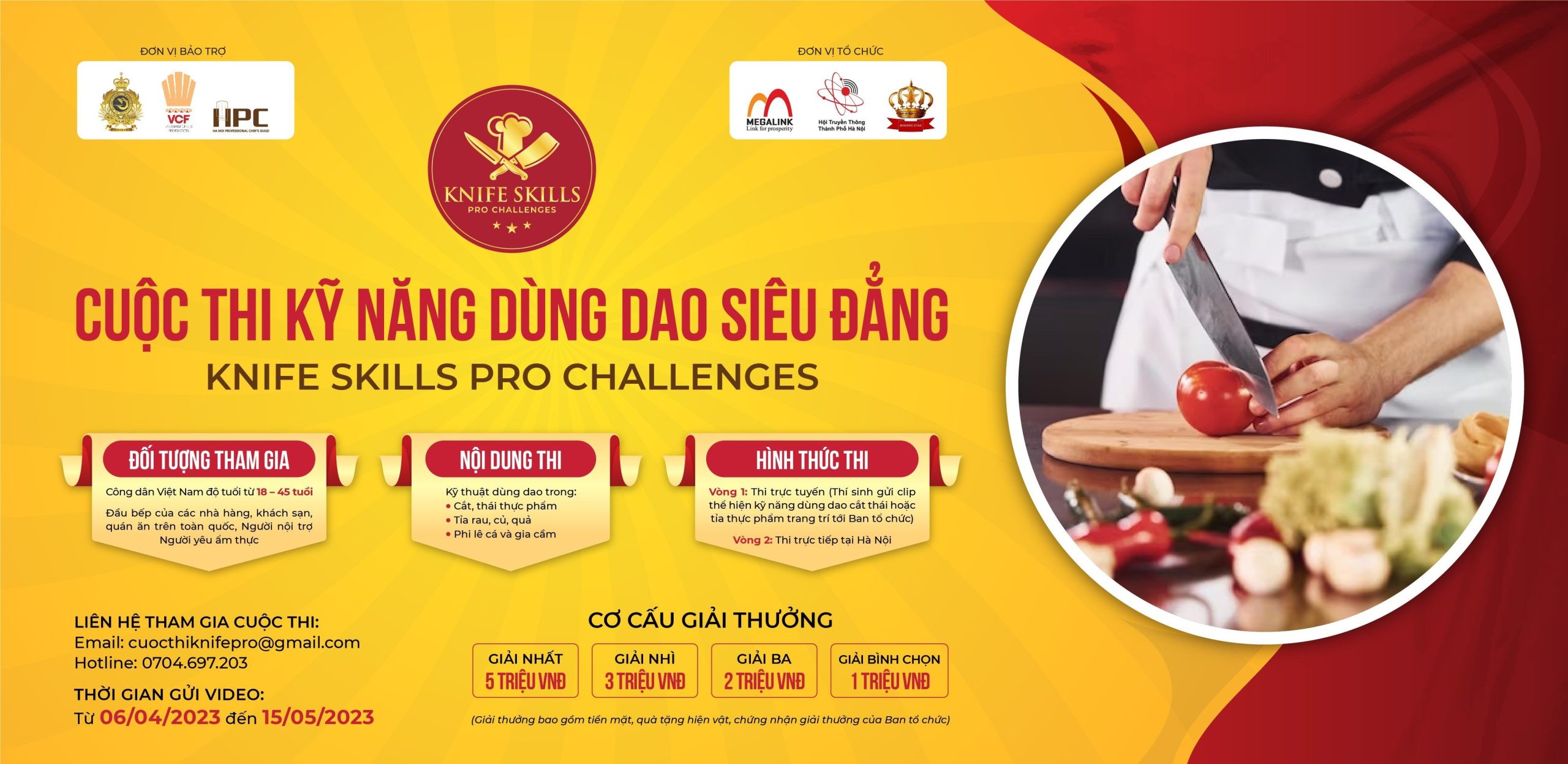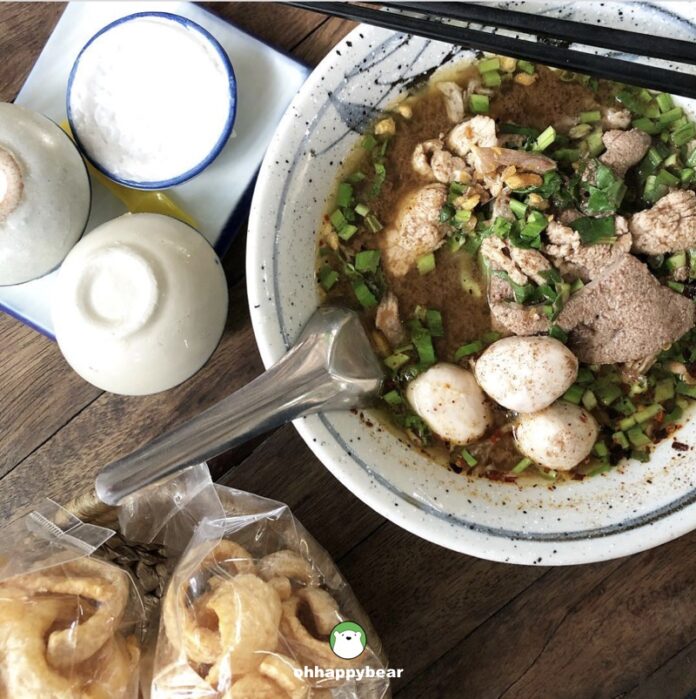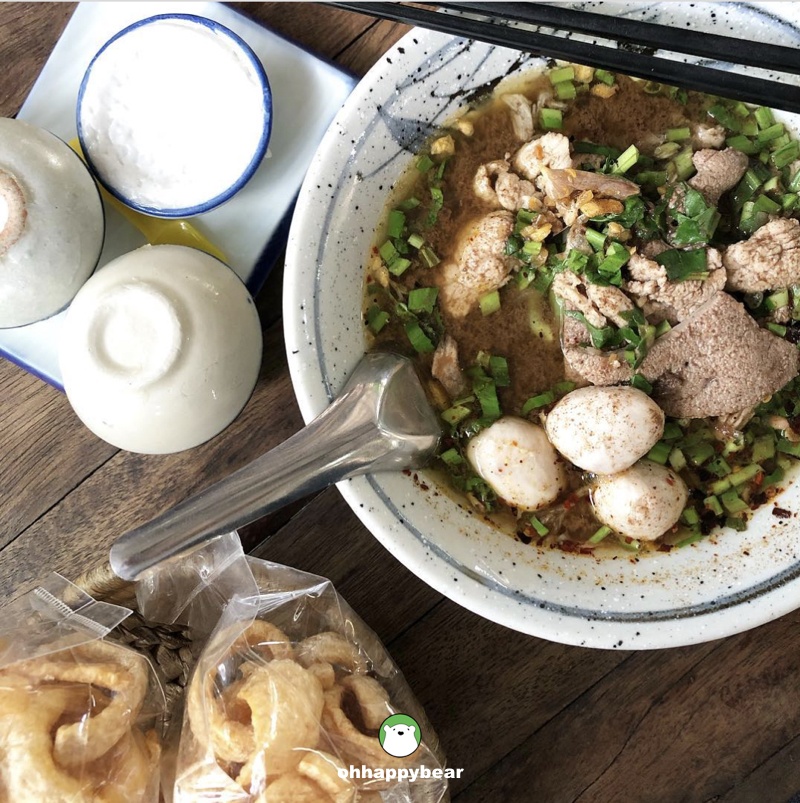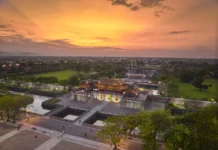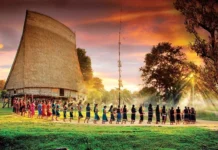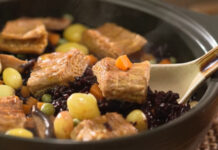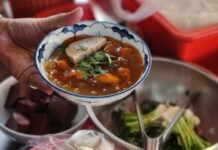- Arharn Jan Diew (Bữa ăn một đĩa)
- Băng Cốc
- Trung tâm
- Những điều cần thiết
- Bản đồ thực phẩm
- Món ăn Thái
Bún thuyền kiểu Thái (Guay Tiew Reur ก๋วยเตี๋ยวเรือ) và những nghi thức ngọt ngào
Bangkok, Thái Lan (10 tháng 1 năm 2021) – Tôi nhớ lần đầu tiên tôi được ăn món mì thuyền Thái, được gọi là Guay Tiew Reur ก๋วยเตี๋ยวเรือ, món thực sự được bán trực tiếp từ thuyền, do đó có tên như vậy. Bữa ăn đó thực sự diễn ra ở Rangsit, một quận có kênh rạch của Pathum Thani, một tỉnh trồng lúa cách Bangkok khoảng 30 km về phía bắc.
Theo trí nhớ của tôi, người bán có một chiếc thuyền thực sự, một chiếc thuyền lớn. Nhưng thay vì di chuyển nó lên xuống kênh đào, họ đã buộc cố định nó bằng một chiếc bè lớn ở bờ và đó là khu vực ăn uống. Chiếc thuyền có nồi, chảo, tất cả những thứ bạn cần để làm mì. Mỗi bát mì đều nhỏ một cách lố bịch. Tôi có thể ăn hết trong một hoặc hai, có thể là ba lần húp. Và mỗi chúng tôi đều kết thúc với một đống bát như vậy ở vạch đích. Một thứ gì đó không khác gì những đống bát đĩa sau một bữa ăn thịnh soạn tại một nhà hàng sushi băng chuyền.
Guay Tiew Reur luôn là một phần của các món ăn chính của Thái Lan. Thường là cho bữa trưa. Thường là, ít nhất là đối với gia đình tôi, vào những ngày cuối tuần khi chúng tôi tụ tập để thưởng thức một món ngon bình thường. Loại mì này, hóa ra, đã ăn sâu vào nền văn hóa Thái Lan. Để viết bài này, tôi đã cố gắng tìm hiểu về nguồn gốc của chúng. Hóa ra, loại mì này thực sự có nguồn gốc và phổ biến ở quận Rangsit, nơi các kênh đào có hệ thống của họ, được đào từ thời Vua Rama V, thực sự được các cộng đồng sử dụng làm đường cao tốc của món ngon này vào thời đó.
Nguồn gốc của Guay Tiew Reur | กำเนิดก๋วยเตี๋ยวเรือ
Với tư cách là một nhà văn, tôi luôn thấy ngạc nhiên khi những món ăn mà tôi sắp viết về luôn có một cuộc sống vượt xa sự hiện diện đơn thuần của chúng trên bàn ăn. Thông thường, những cuộc sống đó gắn chặt với những cách sống đã tạo ra chúng ngay từ đầu. Trong trường hợp của Guay Tiew Reur, ngoài trí nhớ của tôi, tôi tìm kiếm “Guay Tiew Reur Rangsit” và thấy nó ở đó. Một số câu chuyện dài dòng về cách mì lần đầu tiên xuất hiện trong bếp Thái vào thời Ayutthaya khi Xiêm lần đầu tiên giao thương với các thương gia nước ngoài, nhưng sau đó, rất nhiều phát hiện cũng chỉ ra rằng loại mì đặc biệt này lần đầu tiên được nấu trong các kênh đào của Rangsit, nơi tôi tình cờ nếm thử món mì đầu tiên. Cảm ơn mẹ và bố vì đã cho tôi biết về hành trình ẩm thực độc đáo đó.
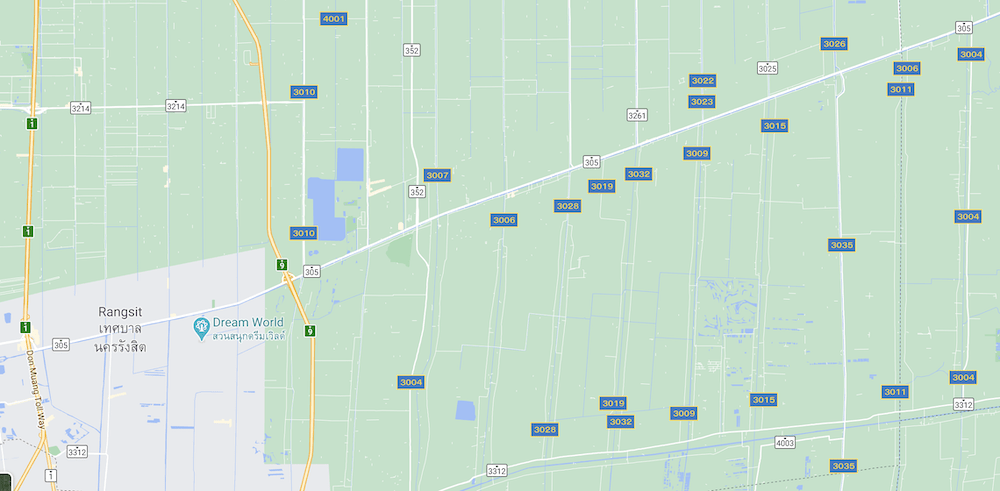
Klong Rangsit, as they are collectively known, is actually a lot of canals. As you can see from the map above, those canals created a grid-like pattern of the green lands as they were intended to provide systematic irrigation to the region that King Rama V himself deemed to promote as a rice-growing county for Siam. Today, Rangsit is designated by the numbers of the canal. Rangsit Klong 5 means exactly at the location of Canal No. 5, which sits between Canal No. 4, and Canal No. 6. And that system has been perpetuated as the official postal addresses of the present as well.
The story also has it that Guay Tiew Reur was really first sold off a boat in Rangsit. The characteristic tiny bowls stemmed from the very nature of the sellers who usually operated their typically narrow boats singlehandedly. And from rowing their boat, singing their noodle songs, and making the noodles, they have no time and energy left to handle any larger containers. These tiny bowls were also considered to fit the narrowness of the boat. But market-wise, I guess they did it so that people would ask for more and more. After all, who could have stopped themselves at the first few slurps of these delicious noodles?
What does a bowl of Thai-style Guay Tiew Reur taste like? ก๋วยเตี๋ยวเรือรสชาติเป็นอย่างไร
As you can see from the pictures, a bowl of Guay Tiew Reur has a distinctive look. The broth is deep reddish-brown, speckled with pork or beef blood. It is usually spiced with a concoction of secret herbs. In the old days, there were even some mentioning of cannabis as part of the ‘addictive’ broth, but of course, there’s no way someone would confirm that. The noodle choices in Guay Tiew Reur are usually Sen Lek (mid-width flat rice noodle) or Sen Mee (rice vermicelli), but hardly Sen Yai (wide flat rice noodle) and never Ba Mee (egg noodle). The choices of meats usually oscillate between pork and beef. And you can order the broth with or without blood by saying ‘Nam Tok’ = with blood, or ‘Mai Nam Tok’ = without blood. My choice is always the latter because I am a proud wimp.
Unlike other types of Thai noodles that usually contain beansprouts as the main veggie, a bowl of boat noodle’s staple green is the fat and crunchy morning glory. We call this one Pak Bung Thai ผักบุ้งไทย. I think this is geographically correct, given that this noodle was originated by the canals, the place where lots of that kind of morning glory thrive naturally. The garnishes are also different, with the inclusion of sawtooth coriander or ‘culantro’ or Pak Chee Farang ผักชีฝรั่ง, with its distinct aroma and texture, into the common mixture of cilantro and spring onion.
In terms of the broth, boat noodle is usually spicy and tangy, to begin with. The broth is usually pre-seasoned with toasted chilies and chili-vinegar before serving. And of course, people will add more condiments at the table, plus some fresh sprigs of Thai basils (called ‘Horapha’), beansprouts, and puffy pork crackles called ‘Kap Moo.’
And now you know why one bowl is never ever enough.
How Thai People Eat Boat Noodles | วิถีก๋วยเตี๋ยวเรือของคนไทย
Going to a boat noodle place exudes a uniquely fun vibe. A license to load up. Sometimes, sanitary and hygiene just go out the window. In some people’s minds, the dingier the place, the better. So, it is not unusual that someone you know, either self-proclaimed or otherwise, to be foodies, would let it slip that their favourite spot for boat noodle happens to be at a water-clogged area near a very dirty canal, under dilapidating canvas umbrella shades, complete with the smell from that canal. 
I usually associate a boat noodle meal with lots of side dishes. BBQ pork or beef balls on skewers, so-called ‘Look Chin Ping’ ลูกชิ้นปิ้ง, for one. Moo Satay หมูสะเต๊ะ, if available, is also another delicious option. If that place serves the noodles in traditional tiny bowls, I would have to have at least five bowls and then we can speak. But now that the noodle has become urbanised, and lot of places had upsized the containers, and that means one or two bowls will fill me happily. A lot of places in town also serve these fiery boat noodles in a much cleaner, if not posh, environment. A proof that you don’t have to endure the canal smell to get to the real tastes.
But then, a meal of boat noodles can never be completed without the sweet ending. And, for me, the staple must be Kanom Tuay ขนมถ้วย – the very delicious steamed coconut custard puddings served in shallow sauce bowls. This Kanom Tuay, as in passing as they are when it comes to a boat noodle meal, is something I think that makes or breaks the deal for me. A good Kanom Tuay, the one that is creamy, fragrant, with a nice touch of soft and chewy texture and pandanus scent, is something someone like me lives by as they are the sweet ending perfect for this fiery meal.

